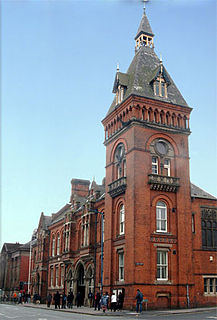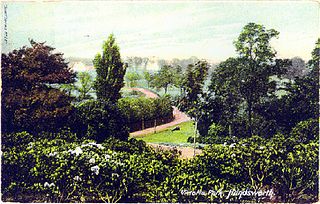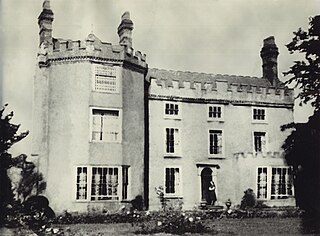
West Bromwich is a large market town in the borough of Sandwell, West Midlands, England. Historically part of Staffordshire, it is 6.4 miles (10.3 km) northwest of Birmingham. West Bromwich is part of the area known as the Black Country, in terms of geography, culture, and dialect. West Bromwich had a population of almost 78,000 in 2018.

Clapham Park is an area in the Borough of Lambeth in London, to the south of central Clapham and west of Brixton.

Great Barr Hall is an 18th-century mansion situated at Pheasey, Walsall, on the border with Great Barr, Birmingham, West Midlands, England. It has associations with the Lunar Society and is a Grade II listed building. It is, however, in a very poor state of repair and is on the Buildings at Risk Register.

Villa Park is a football stadium in Aston, Birmingham, England, with a seating capacity of 42,749. It has been the home of Premier League side Aston Villa since 1897. The ground is less than a mile from both Witton and Aston railway stations and has hosted sixteen England internationals at senior level, the first in 1899 and the most recent in 2005. Villa Park has hosted 55 FA Cup semi-finals, more than any other stadium.

Erdington is a suburb and ward of Birmingham that is historically part of Warwickshire. It is 5 miles (8 km) northeast of central Birmingham, England and borders Sutton Coldfield. It was also a council constituency, managed by its own district committee. The former council district consisted of the ward of Erdington, and Tyburn,, Stockland Green and Kingstanding, although all of Kingstanding and most of both Tyburn and Stockland Green wards lie outside the historical boundaries of Erdington. Stockland Green was formerly part of Aston, Kingstanding part of Perry Barr and Tyburn partially split between Aston and Hodge Hill. Erdington (ward) was part of the Sutton Coldfield constituency before 1974.

Perry Barr is a suburban area in north Birmingham, England. It is also the name of a council constituency, managed by its own district committee. Birmingham Perry Barr is also a parliamentary constituency; its Member of Parliament is Khalid Mahmood.

Acocks Green is an area and ward of southeast Birmingham, England. It is named after the Acock family, who built a large house there in 1370. Acocks Green is one of four wards making up Yardley formal district. It is occasionally spelled "Acock's Green". It has frequently been noted on lists of unusual place names.
Perry Beeches is an area of Great Barr, Birmingham, England, within the parliamentary constituency of Perry Barr.

Castle Vale is a housing estate located between Erdington, Minworth and Castle Bromwich. Currently Castle Vale makes up the Castle Vale Ward of Birmingham City Council which is part of Erdington constituency, 6 miles (9 km) northeast of Birmingham city centre in England. The area has an approximate population of 10,000 people and has a distinctly modern residential character stemming from its history as a postwar overspill estate.

Walmley is a village in Sutton Coldfield, Birmingham, England. It is in south Sutton Coldfield, near to Erdington, Minworth, Wylde Green, Pype Hayes and south of Thimble End. It is approximately 6 miles (9.7 km) northeast of Birmingham City Centre. It is the main focus of the Sutton New Hall Birmingham City Council ward.

Witton is an inner city area in Birmingham, England, in the metropolitan county of the West Midlands. It was within the ancient parish of Aston in the Hemlingford hundred of the historic county of Warwickshire. It is known as the home of Aston Villa Football Club at Villa Park.

Lee Bank was an inner city area of Birmingham, England. It was part of the Edgbaston and Ladywood wards, inside the Ring Road, which surrounds Central Birmingham.

Handsworth Park is a park in the Handsworth area of Birmingham, England. It lies 15 minutes by bus from the centre of Birmingham and comprises 63 acres of landscaped grass slopes, including a large boating lake and a smaller pond fed by the Farcroft and Grove Brooks, flower beds, mature trees and shrubs with a diversity of wildlife, adjoining St. Mary's Church, Handsworth to the north, containing the graves of the fathers of the Industrial Revolution, James Watt, Matthew Boulton and William Murdoch, and the founders of Aston Villa Football Club and the Victoria Jubilee Allotments site to the south opened on 12 June 2010. The completion of a £9.5 million restoration and rejuvenation of Handsworth Park was celebrated with a Grand Re-Opening Celebration led by Councillor Mike Sharpe, the Lord Mayor of Birmingham, speaking from the restored bandstand at 2.00pm on Saturday 8 July 2006, followed by a count down by a large enthusiastic crowd and the release of clouds of confetti; in the words of one observer "Great wedding! Now we must make the marriage a success."

Falcon Lodge is the area of Sutton Coldfield, Birmingham, West Midlands, England, covered in predominantly council houses forming the Falcon Lodge Estate. It is located between Whitehouse Common and Reddicap Heath. To the west of the estate lies Rectory Park. It forms part of the edge of the Sutton Coldfield conurbation and the English countryside.

Tipton Green is the central area of Tipton, a town in the West Midlands of England. It was heavily developed for heavy industry and housing during the 19th century, as Tipton was one of the most significant towns during the Industrial Revolution. Tipton Green is one of three electoral wards covering Tipton for Sandwell Metropolitan Borough Council. The population of this Sandwell ward taken at the 2011 census was 12,834. It is represented by three Labour councillors.

Kingstanding is an area in north Birmingham, England. It gives its name to a ward in the Erdington council constituency. Kingstanding ward includes the areas; Perry Common, Witton Lakes and Wyrley Birch. The other part of Kingstanding falls under the Oscott ward.

The Sentinels are two 90 metre tall residential tower blocks on Holloway Head in Birmingham, England. The two towers, called Clydesdale Tower and Cleveland Tower, are both 31 storeys tall and were part of a major regeneration and council home building scheme following World War II which in the 1960s and 1970s saw the construction of hundreds of tower blocks. Originally built and operated by the City of Birmingham, the buildings were part of a stock transfer from Birmingham local authority to Optima Community Association in 1999, and today the buildings are owned by Citizen housing association. The Sentinels were the tallest purely residential tower blocks in the city until the completion of the 102 metre tall skyscraper Bank Tower 2 in 2019. They are also surpassed by the 122 metre tall newer Radisson Blu directly across Holloway Circus Queensway with 40 floors but this incorporates a hotel as residences.

Highfields Park is Grade II listed park providing 121 acres (49 ha) of public space, in the west of Nottingham, England. It is owned and maintained by Nottingham City Council. It located alongside University Boulevard, adjoining the University of Nottingham's University Park campus. Due to its proximity to the university campus to the north, Highfields Park appears to be a part of the campus itself and therefore many refer to the whole area as University Park. There are historical ties between the park and the campus. The park contains a boating lake, complete with boats to hire throughout the summer months. The cascade and the stepping stones at the western end are Grade II listed. To the south of the lake the Tottle Brook, a tributary of the River Trent, flows on the surface, this brook is culverted for much of its length. At the eastern end there are children's play facilities and a pavilion with a cafe.

Witton Isolation Hospital was a facility for the treatment and quarantine of smallpox victims and their contacts in Birmingham, England, from 1894 to 1966.

Public housing provided the majority of rented accommodation in the United Kingdom until 2011 when the number of households in private rental housing surpassed the number in social housing. Houses and flats built for public or social housing use are built by or for local authorities and known as council houses, though since the 1980s the role of non-profit housing associations became more important and subsequently the term "social housing" became more widely used, as technically council housing only refers to housing owned by a local authority, though the terms are largely used interchangeably. Before 1865, housing for the poor was provided solely by the private sector. Council houses were built on council estates, where other amenities, like schools and shops, were often also provided. From the 1950s, blocks of flats and three-or-four-storey blocks of maisonettes were widely built, alongside large developments of terraced housing, while the 1960s and the 1970s saw construction of many high-rise tower blocks. Flats and houses were also built in mixed estates.
















